15 August
1999
Close Encounter with a Model 4005 Bass
By Peter McCormack Close Encounters No Comments

Modified 1967 4005 Fireglo
The British Invasion
From my viewpoint, there is no more attractive and unique bass than the Rickenbacker Model 4005. It is simply one of those designs that has instant appeal with regard to look and sound. At the peak of the British Invasion, during the mid 1960’s, Rickenbacker International Corporation began to receive orders from England for hollow body basses. Both Hofner and Gibson had already established a loyal following for such basses. Rickenbacker instruments were particularly sought after their use by the Beatles. While Rickenbacker was not the first company to produce the hollow body bass line, their crafting of this style of bass was and continues to be perhaps the most eloquent and prized. The full body photograph of the 1967, 4005 Fireglo displayed above reveals the striking similarity between this instrument and the 360 series from which it was based. The rounded top horn and distinctively smaller lower bout is unmistakably Rickenbacker and illustrative of perhaps the most quintessential of all guitar architectures. With the double cutaway the 4005 was initially available in the famous Fireglo and Mapleglo finishes. In the 1970’s the 4005 was available in the standard line of Colorglo finishes. There are noteable exceptions to this rule with a variety of colorglo finishes produced in the late 1960’s. One example is the dark purple, almost black, finish shown in a photo of a 1968 4005 Burgundyglo that was owned by John Williams at one time. Of interest is the observation that over the years there has been a fairly wide range of colors associated with Burgundyglo. This can be seen by comparing John William’s 4005 with a photo provided by Mike Parks. Another striking color is Midnightblue as seen in the 1968 Model 4005 owned by Oyama Katsuyuki.
The modifications made to the fretboard and trussrod cover of the 1967 4005 under examination become most evident when compared to a photo of the same model from the Rickenbacker International Corporation’s 1968 catalog, also in Fireglo, shown below.
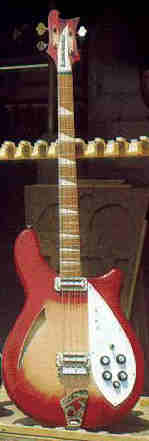
Newly Finished 4005 Fireglo
on the Factory Rack in 1968
The Headstock
The headstock of the 4005 maintained the traditional shape that had become the icon of Rickenbacker basses since the early 4000 model. The 4005 pictured below has had a couple for modifications to the headstock including a new black Rickenbacker truss-rod cover and new chrome tuning pegs.
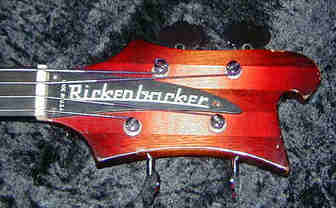
Laminated Maple and Walnut
Headstock from 1967 4005 Fireglo
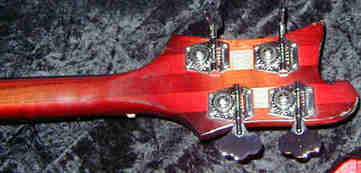
Back View of Headstock
showing replaced tuning pegs
The laminated construction of the 4005 headstock is clearly visible here through the classic and most popular Fireglo finish.
The Neck
The famous Rickenbacker neck construction leading to its renowned playability contained two truss-rods ensuring adjustments that would enable the best possible action in the hands of the right technician. The truss-rod systems required that the neck of the instrument be gently bent into position and then the truss-rods tightened to hold the neck accordingly. The 4005 boasted Deluxe appointments including Pearl Style triangular fret inlays on a 33 and one half inch scale with 20 frets. The neck and binding on the 1967 4005 is evident below.

Back View 1967 4005 showing
headstock, neck and body binding
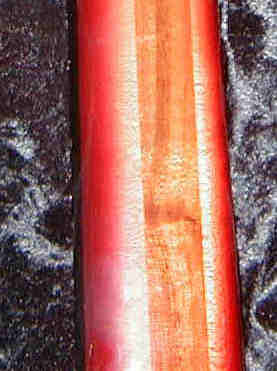
Closeup of 1967 4005 Neck
The Body
The 4005 body is constructed from seasoned maple appointed with nickelplated hardware including the renowned “R” tailpiece. It has a six way adjustable bridge and two “toaster” pickups. These pickups, used on countless Rickenbacker guitars, has a wide frequency band and are highly effective a bass pickups producing a different quality sound compared to the highly popularized “horseshoe” pickup. Its electronics consist of a three position selector switch, two volume and two tone control knobs and a “fifth:” knob or master switch. The “Rick-o-sound” feature provided for both stereo and mono output jacks. The instrument was also designed with a bass mute under the strings. These features are evident on the 1967 4005 model shown below. A more thorough review of the front and back of the 4005 is seen in a comparison of 1967 and 1968 instruments, both in Fireglo finish.
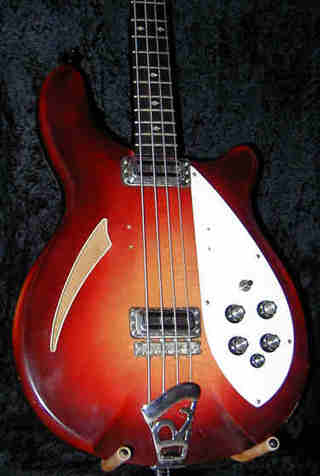
1967 4005 Body
An examination of the 1967 4005 body reveals the presence of two pairs of holes drilled in the pickguard about midway between the pickups, above and below the strings. These holes were for a finger-rest available on a number of Rickenbacker basses. It is evident that the finger-rest was moved and then removed from the model here altogether. A look at the 1975 4005 Rickenbacker below reveals the absence of this finger rest.
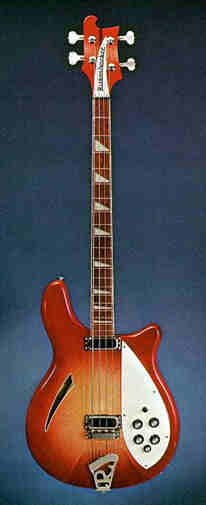
1975 Model 4005
from RIC Catalog
A clearly visible finger-rest is evident in the following photo of a 4005/8.
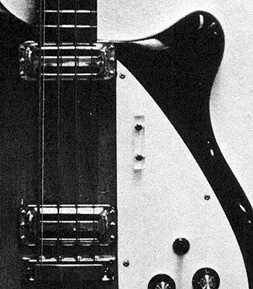
Finger-rest on the 4005/8
A closer look at the “blocked” binding featured on the 4005 is evident in the photo below. This style of binding has also been referred to as “checked” or “checkered” binding for due to its checkerboard appearance. A close look at the photo below will also reveal that the strap button has also been replaced from the original.
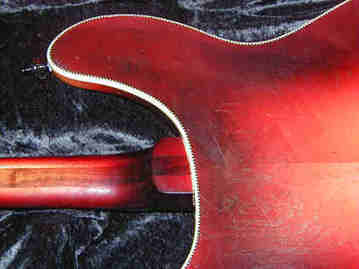
“Block” Binding on 1967 4005
Other 4005 Models
The 4005 model was introduced in 1965 and followed thereafter by 4005/6, a six string model and 4005/8, an eight string bass. Pictured below is a Model 4005/6 Rickenbacker bass in Mapleglo. This is one of only a limited number of such models thought to be made by Rickenbacker International Corporation in the 1960’s. This particular bass was owned by Alvin Lee of the group “Ten Years After.” It is believed that this model was made in approximately 1967. Notice that the classic headstock shape is preserved in the 4005/6. The model was constructed with a bound sound-hole and binding on the back of its body as well. A close look at this instrument would suggest that it has been set up as a guitar. This conclusion is based on the small gauge of the strings on this bass and the presence of what would appear to be a six string guitar bridge. The following photo is posted with the kind permission of Mr. Gary Hernandez of San Diego Guitars.
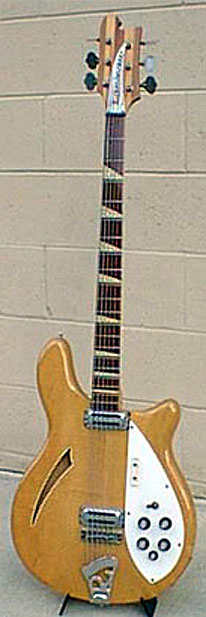
Circa 1967 Model 4005/6 in Mapleglo
Courtesy of Mr. Gary Hernandez
San Diego Guitars
The 4005/8, of which only a few were made, had the string pairs tuned in octaves. This arrangement required a different shape headstock to allow for the additional tuners required and is shown here as depicted in Richard Smith’s 1978 publication.
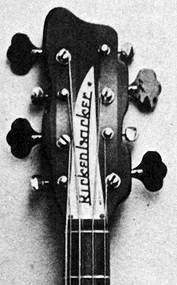
Different Shape 4005/8 Headstock
A beautiful example of the 4005/8 is the 1967 4005/8 Mapleglo O.S. owned by Oyama Katsuyuki. His vintage instrument has all dispalys the unique headstock shape, finger-rest and binding. The mapleglo finish provides a natural and beautiful contrast to the fingerboard and the triangle fret markers in this 1967 model. Also referred to as a 4005WB, these models had binding on both sides of the bass. A 1975 4005WB is shown in the photo below. These models were referred to a 4005 O.S. and a few 4005/6 O.S. basses were also produced in the 1960’s.
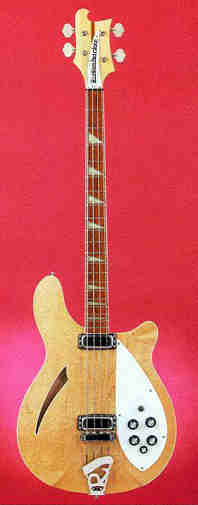
1975 Model 4005WB
from RIC catalog
Apparently Rickenbacker also produced at least one 4005/5, a five string, in 1972. Additional 4005 models included a 4005L or 4005 Light Show in the early 1970’s. Very few of these instruments were made and a photo of Jack Casady’s is seen immediately following this text. A pristine 1968 4005 LS specimen is seen in the Oyama Katsuyuki collection.
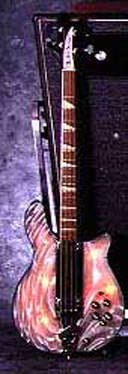
4005L owned at one time by
The Jefferson Airplane’s Jack Casady
Artists Playing the Model 4005
A number of well known artists have played the Rickenbacker 4005 over the years. Some of these artists have included: Michael Anthony (4005/8 FG) of Van Halen; Jack Casady (4005L) of Jefferson Airplane (see above); Rhett Crowe (4005 Blonde) of Guadalcanal Diary; John Entwistle (4005L) of The Who; Larry Graham (4005 Custom) of Sly and The Family Stone; Mark Hudson (4005 Purpleburst) of Hudson Brothers; Alvin Lee (4005/6 MG) of Ten Years After; Mike Mills (4005) of R.E.M.; Colin Moulding (4005) of XTC; and Gary Mounfield (4005 Custom) of The Stone Roses.
References
- alt.guitar.rickenbacker Newsgroup
- Rickenbacker International Corporation: Online Catalog Section
- Smith, Richard R. Rickenbacker: The History of Rickenbacker Guitars. Fullerton: Centerstream Publishing. 1987
